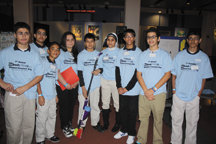Casey Popowki, a sixth grade student at Nicholas Oresko School in Bayonne, noticed that her mother, a teacher, often traveled with two pairs of shoes: High heels and flats. She wore one pair to and from work, then had to change into the other at work. So Popowki wondered: What if there was a pair of shoes that could do both?
This became the kernel of an idea for a project she and her schoolmates – Maggie Bocchino, Vittoria Orlando, Danielle Kaniewski, and Nyla Mulcahy – began on that would later be submitted to the first TeleBrands Green Products Inventors Day at the Liberty Science Center.
The students received third place out of 15 schools in the metropolitan area, earning a $500 scholarship for their school.
“The Swing-It Heel allows women, when they get tired of high heels, to change to a flat shoe,” Kaniewski said.
“The Swing Heel allows women, when they get tired of high heels, to change to a flat shoe.” — Danielle Kaniewski
________
“We wanted to keep this affordable,” she said.
“These are not designer shoes,” Orlando said.“We didn’t want this just for the rich.”
Bocchino said they had a week to put the whole shoe together. The tricky part was finding the hinge for the heel.
Kimberly Weimmer was their science teacher last year, but she worked with the sixth grade students over the summer in order to prepare for this presentation.
Research, development, and marketing were key
Their team was given five minutes to pitch their idea, “The Swing-It Heel,” before a panel that included J. Khubani, the chief executive officer of TeleBrands, the As-Seen-On-TV marketing company; Dr. Emlyn Koster, the CEO of Liberty Science Center; and Mr. Khubani’s 15-year-old son, Jahon.
The three judged the products on how well they solve a common problem, and the inventions also had to feature an ecology-friendly aspect.
The winners – students from ages 8 to 14 – received $500 to $1,000 in scholarships, and a chance to work with TeleBrands to market and sell their invention.
If the program succeeds, Khubani would replicate the project in other similar venues across the country, with the hopes of steering kids toward marketing saleable ideas.
A frequent lecturer at Montclair University, Khubani was instrumental in setting up a similar entrepreneurial program at Princeton University in 2006, the winners of which he takes to Hong Kong to learn about his business. Khubani started his company after graduating college in 1983.
Dr. Koster said that while the partnership with Khubani is new, the concept of practical science goes back to the original concept for the Science Center when it was first envisioned in the early 1980s.
“While this may look like a new development, this idea has been part of the Liberty Science Center since its inception 30 years ago,” he said, noting that for a state rich in pharmaceutical, research, and development companies, New Jersey needed its own science center, focused on science, technology, and their impact on the workforce.
This program, he said, helps teach kids to work in teams, think creatively, generate ideas that are eco-friendly, and learn how to market them.
This program inspired competition from schools to earn scholarships and to bring innovation into the classroom.
“We hope to expand on this and hold one hopefully every year,” he said, calling the whole experience “a pleasant surprise.”
Jersey City also made its pitch
Although not one of the top winners, the Jersey City heights middle school, M.S. No. 7, also made a pitch for a labor saving device called “Tire Savior,” and even made a video as part of their presentation. Team members acted out the parts and demonstrated the uses of their device.
The eighth graders came up with the idea to help people who, either because of age or injury, are not able to bend down to wash their tires.
The students started their brainstorming last June just before school let out and came up with the idea early this school year.
Luis Carraasquillo came up with the idea. Trista Tedada said she tried to imagine what it was like to have to bend down to clean tires when hurt or elderly. Dina Kheir, the project engineer, found a way to create the device, which includes several scrubbing instruments connected to a long handle and a bottle that would contain detergent or water.
Varum Bhandari said it would make it easier to clean the tires, yet is eco-friendly.
Al Sullivan may be reached at asullivan@hudsonreporter.com.
